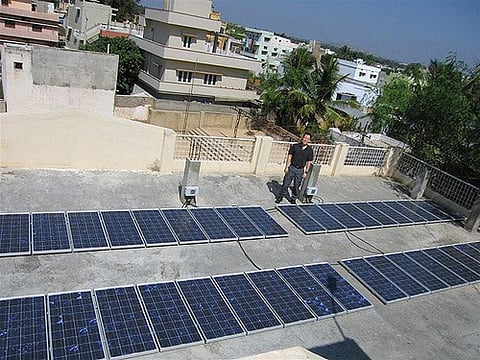Karnataka launches gross metering for solar rooftop
The Karnataka government introduced the state’s solar policy (2014-2021) on May 22, 2014 that declared a total target of 400 MW grid-connected solar rooftop plants and 1,600 MW grid-connected utility-scale solar projects by 2018.
This was part of the Centre’s target of 100,000 MW solar power generation by 2022. In the Karnataka solar policy, rooftop solar power has been incentivised through net metering which means that consumers have to pay the bill net of their export as well as for self consumption.
The policy says that if there is surplus, discoms will pay consumers as per the tariff determined by the Karnataka Electricity Regulatory Commission (KERC). Karnataka is one of the few states that do not limit the size of the solar plants for installation.
The KERC issued an order for the tariff payable for solar rooftop and small photovoltaic power generation plants valid from May 2, 2016 to March 31, 2018.
In this, the KERC introduced gross metering for homes, hospitals and educational institutes. Gross metering is a concept where the distribution company pays the consumers per unit of tariff for every unit exported to the grid usually higher from the tariff charged for consumption.
| Tariff designed for rooftop solar plants in Karnataka | ||
| Capacity of solar rooftop and small photovoltaic power plants | Approved tariff in Rs/unit (without capital subsidy) | Approved tariff in Rs/unit (With capital subsidy) |
| 1 to 10kW | 7.08 | 6.03 |
| Above 10kW & up to 50kW | 6.61 | 5.63 |
| Above 50kW & up to 100kW | 6.14 | 5.23 |
| Above 100kW & up to 500kW | 5.67 | 4.83 |
| Above 500kW & up to 1000kW | 5.20 | 4.43 |
This is a unique change for three reasons:
- This is the first time any state has changed the metering policy from net to gross. This was done either because net metering was not acting as an incentive for consumers to install rooftop solar plants. This is evident from the fact that Karnataka has only 9.5 MW of installed capacity as of February 2016.
- Gross metering is only applicable to homes, hospitals and educational institutes. Net metering still applies to industrial, commercial and all categories of consumers, apart from these three. They have also been given the option that they can export 100 per cent of their power generation irrespective of their self-consumption. This would make these consumers power producers essentially.
- Expansion of rooftop is necessary for states like Karnataka where even urban areas witness a minimum three-hour power cut. But the discoms in the state are already short of cash and suffer huge losses. The gross metering policy will put in more financial burden on discoms.
Even though discoms are trying to increase the share of renewables in the state, there are flaws in their calculations for the tariff of plants.
In the first place, tariffs make an assumption that for a plant of less than 10 KW capacity, the cost of 1 KW system would be only Rs 75,000.
According to an analysis conducted by Delhi-based non-profit Centre for Science and Environment, the cost of a grid connected system would be around Rs 1 lakh. So, the premise of the calculation itself falls short by around 25 per cent.
KERC estimates that the KW price rate for a project between 500 KW and 1 MW (Rs 55,000) is equal to the Central Electricity Regulatory Commission’s benchmark for a large-scale project (Rs 530.02 lakh per MW-Rs 53,000 per KW).
This can hardly be true since MW-scale projects build in the multiples of 50 and 100, and therefore are able to achieve such economies of scale.
Also, all prices that have been quoted are for grid-connected projects, assuming that there is going to be electricity 24X7.
If there is not a battery back-up with the system, a blackout is a blackout. This is one thing most people fail to realise.
Most states have a restricted policy for rooftop solar saying that one can put up a rooftop solar of a partial capacity of the actual demand. There have been restrictions on the grid penetration of solar rooftops. Karnataka allows the maximum penetration of rooftop solar in the country (80 per cent of the transformer capacity).
All these restrictions have been put in to ensure that there are not expenditures that are created for the discoms and getting them deeper into financial trouble. It seems that Karnataka has decided that there is not going to be any restriction on the path to renewable energy development.


